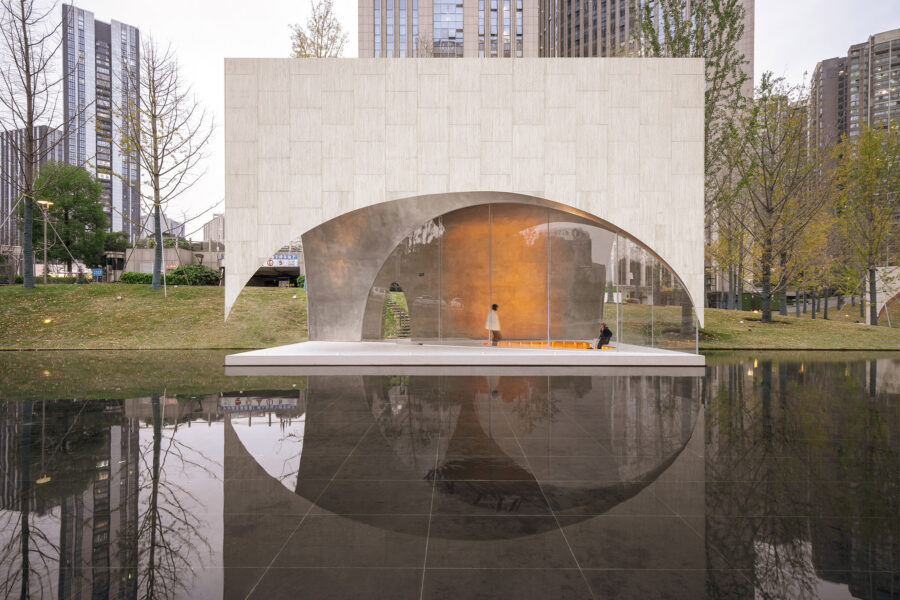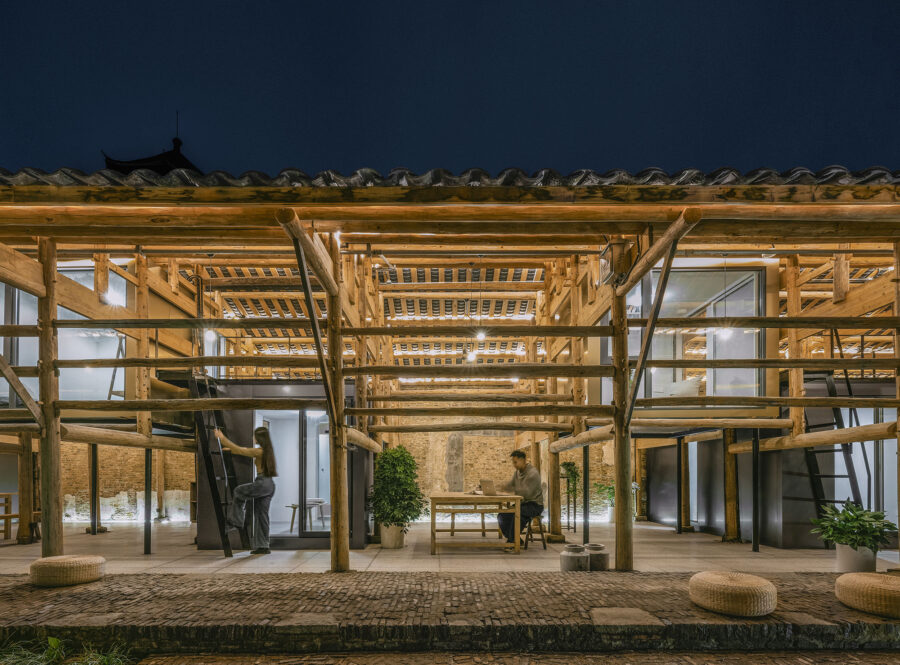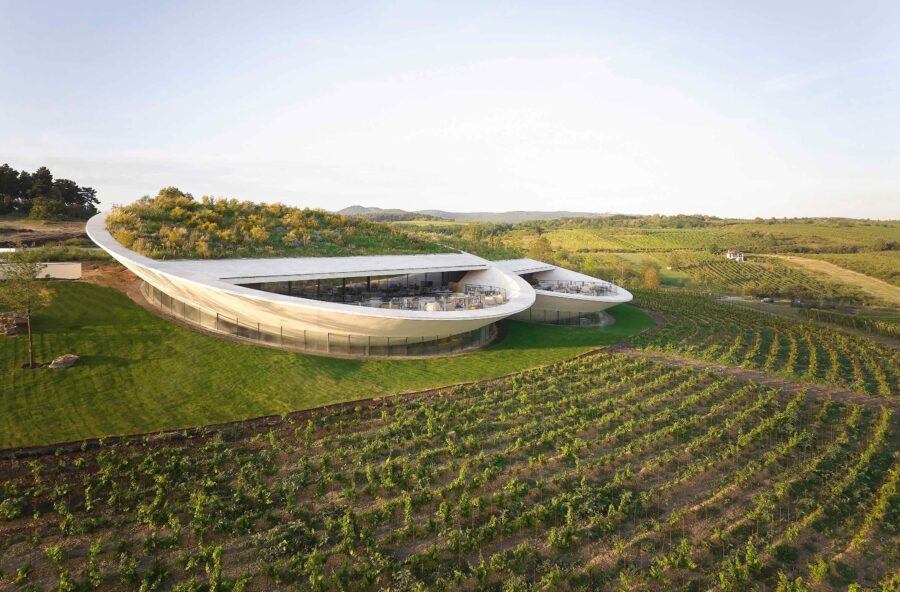
CULTURE


© Jang Mi
韓国の全州(チョンジュ)市に建つ〈Dabang〉は、廃墟となっていた3棟の建物の壁だけを残し、新たな柱と透過性のある屋根で覆った、庭と建築が一体化したカフェです。
放置されてから植物の住処となっていた場所だからこそ、壁や屋根の一部を解体して空気と日光を取り入れることで植物が生育するための環境をつくりつつ、残された壁を用いて小上がりの座席などを提供しています。
ソウルとニューヨークを拠点に活動する設計事務所 one-aftrが設計しました。
(以下、one-aftrから提供されたプレスキットのテキストの抄訳)

© Jang Mi

© Jang Mi
3つの小さな建物、屋根、そして庭
私たちと同じように、植物は成長し、建物は年を重ねる。
この建物における朽ちていくプロセスは自然なものであった。棟木が浸食され、木のフレームが腐り、コンクリート瓦が建物の中に落ちた。こうした構造上の損傷により、屋根は空に向かって開き、床は土に還った。

Preconstruction
かつて工場労働者の寮として使用されていたこの3棟の建物は、近隣の工場が閉鎖されるとともに放置された。
縮小していくまちの中で、荒れ果てた建物の上で、人間は次第に野生の植物へと置き換えられた。その朽ち果てた姿は次第に内庭へと姿を変え、植物たちの聖域となっていた。

Preconstruction

Preconstruction
平行に建っていた3つの長方形の建物それぞれ、北側の最も太い建物は寮を管理する家族の住まいであり、中央の3戸の建物と南端の4戸の細長い建物には、工場労働者とその家族が住んでいた。
ユニットの大きさが12m²と小さく建物間の距離も1.2mと近かったため、既存の用途を維持しながら現代に適合させるのは現実的ではなかった。

© Jang Mi

Plan
残された壁を透過性のある屋根が覆う、庭と一体化した建築空間
この土地に新しい息吹を吹き込むため、私たちは壁と屋根の一部を計画的に取り壊し、より良い空気循環、日光の透過、植物の生育機会、そして人々が歩き回れるスペースを確保した。さらに、既存の建物を構造、設備、空調の負担から解放した。
建物を部分的に解体した後、新たな柱と屋根構造を取り付けた。

© Jang Mi

© Jang Mi

© Jang Mi
現在はカフェとなっている北側の建物は、断熱と空調管理が施された唯一の完全な内部空間である。
中央の建物は、外側の2面以外の壁をすべて取り払った。さらに地面を掘削してサンクンガーデンをつくり、木々や芝生が生い茂るオープンエアの空間を提供する。

© Jang Mi

© Jang Mi
南側の建物は内壁を残しつつ中央の建物と空き地に面した壁は取り壊し、各ユニットは小上がり式の座席に生まれ変わった。また、これらの建物をつなぐため、敷地の東端に細長い通路を設けた。
自然の力によって徐々に朽ち果てていく建物から、この土地に新たな生命を吹き込むための私たちの意図的な取り組みまで、〈Dabang〉は植物、人間、そして建築環境が一体となった聖域を提供している。

© Jang Mi

© Jang Mi

© Jang Mi

© Jang Mi

© Jang Mi

© Jang Mi

© Jang Mi

© Jang Mi

© Jang Mi

© Jang Mi
以下、one-aftrのリリース(英文)です。
Dabang / 다방면
one-aftr (Joon Ma, Ryu Ahn)Year: 2023
Status: Built
Location: 303-22 Palbok-dong 1(il)-ga, Deokjin-gu, Jeonju-si, Jeollabuk-do
Client: City of Jeonju
Photo Credit: Jang Mi
Design Team: Joon Ma, Ryu Ahn, Yoonha Lee, Bomi SonThe three little buildings, a roof, and a garden.
Just like us, plants grow and buildings age.
The process of decay in this particular case was natural. Concrete roof tiles fell into the building as purlins eroded and timber frames rotted away. Due to these structural damages, the roof opened up to the sky, and the floor reverted to earth. These three buildings, once used as a dormitory for factory workers, were abandoned as nearby factories closed. In a shrinking town, on a distressed building, humans were gradually replaced by wild plants. This decay gradually transformed the site into an interior garden, providing a sanctuary for plants.
The three rectangular-shaped buildings stood parallel to one another. The thickest building on the northern side served as the home for the family who managed the dorm, while the other two slender buildings, one with three units in the middle and the other with four units on the southern end, housed factory workers and their families. The small unit sizes (12 sqm) and the proximity of the buildings (1.2m) made it impractical to fully maintain the existing structure for modern-day use.
In our effort to breathe new life into this site, we systematically demolished sections of the walls and roof to allow for better air circulation, sunlight penetration, opportunities for plant growth, and spaces for people to roam. Furthermore, liberating the existing building from its structural, MEP, HVAC burdens.
After partially deconstructing the buildings, new columns and roof structures were installed. The northern building, now a café, is the only fully interiorized space, insulated and climate controlled. In the middle building, all walls were removed except for the two exterior sides. We excavated the ground further to create a sunken garden, providing an open-air space for trees and grass to thrive. The southern building had its interior walls preserved, but the ones facing the middle building and the vacant lot were demolished. Those units were then transformed into raised floor seating. To connect the existing buildings, we constructed an elongated pathway on the eastern end of the site.
From their gradual decay in the face of nature’s forces to our deliberate efforts to breathe new life into this site, Dabang offers a sanctuary that integrates plants, humans, and the built environment.
「Dabang」one-aftr 公式サイト









